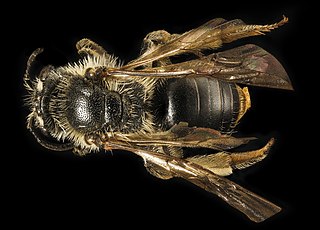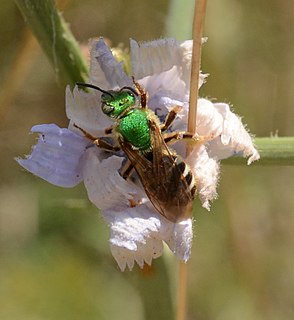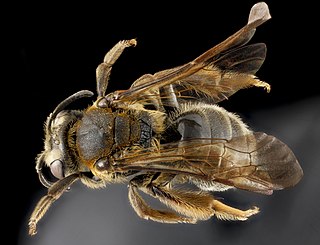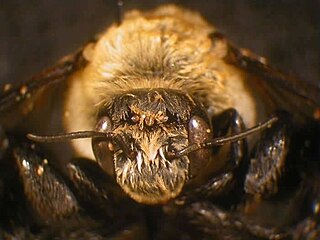
Obdurodon is a genus of extinct monotreme. They appeared much like their modern day relative the platypus, except adults retained their molar teeth. Unlike the platypus which forages on the lakebed, Obdurodon may have foraged in the water column or surface.

Halictidae is the second-largest family of Anthophila bees. Halictid species occur all over the world and are usually dark-colored and often metallic in appearance. Several species are all or partly green and a few are red; a number of them have yellow markings, especially the males, which commonly have yellow faces, a pattern widespread among the various families of bees. The family is distinguished by the arcuate basal vein found on the wing.

Hoplitis is a genus of bees in the family Megachilidae. There are more than 380 described species in Hoplitis.

Anthidiellum notatum, the northern rotund-resin bee, is a species of bee in the family Megachilidae. It is found in North America.

The Forbes's miner bee is a species of miner bee in the family Andrenidae. Another common name for this species is the Forbes' andrena. It is found in North America.
Sphecodosoma is a genus of sweat bees in the family Halictidae. There are at least three described species in Sphecodosoma.

Rophitinae is a subfamily of sweat bees in the family Halictidae. There are about 13 genera and more than 260 described species in Rophitinae.
The black and blue miner bee is a species of miner bee in the family Andrenidae. Another common name for this species is the blue-and-black andrena. It is found in North America.

Agapostemon virescens, the bicolored striped-sweat bee, is a species of sweat bee in the family Halictidae. It is found in North America.

The neighbouring miner bee is a species of miner bee in the family Andrenidae. Another common name for this species is the neighborly miner. It is found in North America.

Melissodes communis, the common long-horned bee, is a species of long-horned bee in the family Apidae. It is found in Central America and North America.

The snow miner bee is a species of miner bee in the family Andrenidae. Another common name for this species is the snowy miner. It is found in North America.
The regular miner bee is a species of miner bee in the family Andrenidae. It is found in North America.
The pale-faced miner bee is a species of miner bee in the family Andrenidae. Another common name for this species is the pale-fovea andrena. It is found in Central America and North America.

The Appalachian miner bee is a species of miner bee in the family Andrenidae. Another common name for this species is Alleghany andrena. It is found in North America.

The sunflower miner bee is a species of miner bee in the family Andrenidae. Another common name for this species is the sunflower andrena. It is found in North America.

The geranium miner bee is a species of miner bee in the family Andrenidae. Another common name for this species is the geranium andrena. It is found in North America.
The Haynes's miner bee is a species of miner bee in the family Andrenidae. Another common name for this species is the Haynes' andrena. It is found in North America.
The intact miner bee is a species of miner bee in the family Andrenidae. Another common name for this species is the short-haired dogwood andrena. It is found in North America.

Ptilothrix bombiformis, known generally as the hibiscus bee or eastern digger bee, is a species of chimney bee in the family Apidae. It is found in Central America and North America.













